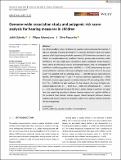Files in this item
Genome-wide association study and polygenic risk score analysis for hearing measures in children
Item metadata
| dc.contributor.author | Schmitz, Judith | |
| dc.contributor.author | Abbondanza, Filippo | |
| dc.contributor.author | Paracchini, Silvia | |
| dc.date.accessioned | 2021-09-03T16:30:07Z | |
| dc.date.available | 2021-09-03T16:30:07Z | |
| dc.date.issued | 2021-09-03 | |
| dc.identifier | 275628579 | |
| dc.identifier | b1880240-dbfa-460c-9d3e-b7e081a4fae2 | |
| dc.identifier | 85114085493 | |
| dc.identifier | 000692666000001 | |
| dc.identifier.citation | Schmitz , J , Abbondanza , F & Paracchini , S 2021 , ' Genome-wide association study and polygenic risk score analysis for hearing measures in children ' , American Journal of Medical Genetics. Part B, Neuropsychiatric Genetics , vol. Early View . https://doi.org/10.1002/ajmg.b.32873 | en |
| dc.identifier.issn | 1552-4841 | |
| dc.identifier.other | ORCID: /0000-0001-9934-8602/work/99466114 | |
| dc.identifier.uri | https://hdl.handle.net/10023/23898 | |
| dc.description | Funding information: Deutsche Forschungsgemeinschaft, Grant/Award Number: SCHM 3530/1-1 (418445085); Royal Society, Grant/Award Number: UF150663; UK Medical Research Council and Wellcome, Grant/Award Number: 217065/Z/19/Z; Wellcome Trust, Grant/Award Number: 105621/Z/14/Z | en |
| dc.description.abstract | An efficient auditory system contributes to cognitive and psychosocial development. A right ear advantage in hearing thresholds (HTs) has been described in adults and atypical patterns of left/right hearing threshold asymmetry (HTA) have been described for psychiatric and neurodevelopmental conditions. Previous genome-wide association studies (GWASs) on HT have mainly been conducted in elderly participants whose hearing is more likely to be affected by external environmental factors. Here, we investigated HT and HTA in a children population cohort (ALSPAC, n = 6,743). Better hearing was associated with better cognitive performance and higher socioeconomic status. At the group level, HTA suggested a left ear advantage (mean = −0.28 dB) that was mainly driven by females. SNP heritability for HT and HTA was 0.13 and 0.02, respectively (n = 4,989). We found a modest negative genetic correlation between HT and reading ability. GWAS for HT (n = 5,344) did not yield significant hits but polygenic risk scores for higher educational attainment (EA, ß = −1,564.72, p = .008) and schizophrenia (ß = −241.14, p = .004) were associated with lower HT, that is, better hearing. In summary, we report new data supporting associations between hearing measures and cognitive abilities at the behavioral level. Genetic analysis suggests shared biological pathways between cognitive and sensory systems and provides evidence for a positive outcome of genetic risk for schizophrenia. | |
| dc.format.extent | 11 | |
| dc.format.extent | 1708595 | |
| dc.language.iso | eng | |
| dc.relation.ispartof | American Journal of Medical Genetics. Part B, Neuropsychiatric Genetics | en |
| dc.subject | QH426 Genetics | en |
| dc.subject | RC0321 Neuroscience. Biological psychiatry. Neuropsychiatry | en |
| dc.subject | DAS | en |
| dc.subject.lcc | QH426 | en |
| dc.subject.lcc | RC0321 | en |
| dc.title | Genome-wide association study and polygenic risk score analysis for hearing measures in children | en |
| dc.type | Journal article | en |
| dc.contributor.sponsor | The Wellcome Trust | en |
| dc.contributor.institution | University of St Andrews. School of Medicine | en |
| dc.contributor.institution | University of St Andrews. Cellular Medicine Division | en |
| dc.contributor.institution | University of St Andrews. Centre for Biophotonics | en |
| dc.contributor.institution | University of St Andrews. Biomedical Sciences Research Complex | en |
| dc.contributor.institution | University of St Andrews. St Andrews Bioinformatics Unit | en |
| dc.identifier.doi | 10.1002/ajmg.b.32873 | |
| dc.description.status | Peer reviewed | en |
| dc.identifier.grantnumber | 105621/Z/14/Z | en |
This item appears in the following Collection(s)
Items in the St Andrews Research Repository are protected by copyright, with all rights reserved, unless otherwise indicated.

